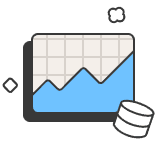
In today's data-driven world, the term "data application" has become increasingly prevalent. But what exactly is a data application, and why is it crucial for modern businesses and organizations? This page will describe the concept, and explore its components, benefits, and real-world applications.
Definition of a Data Application
A data application is a software solution designed to collect, process, analyze, and visualize data to solve specific business problems or support decision-making processes. Unlike traditional applications that focus primarily on user interactions, data applications prioritize data manipulation, analysis, and insights generation.
Key Components of Data Applications
1. Data Ingestion Data applications start with robust data ingestion capabilities. This involves collecting data from various sources, such as databases, APIs, streaming platforms, or file systems. The ingestion process must handle different data formats and ensure data quality and consistency.
2. Data Processing and Transformation Once ingested, data often requires cleaning, normalization, and transformation. This step involves applying business logic, handling missing values, and preparing the data for analysis.
3. Data Storage Efficient data storage is crucial for data applications. This may involve traditional relational databases, NoSQL databases, data warehouses, or data lakes. The choice depends on the application's specific requirements, such as data volume, velocity, and variety.
4. Analysis Engine The heart of a data application is its analysis engine. This component executes complex queries, applies statistical models, or runs machine learning algorithms to extract insights from the data.
5. Visualization Layer Data applications often include a visualization layer to present insights in an easily digestible format. This can range from simple charts and graphs to interactive dashboards and complex data storytelling tools.
6. User Interface While not always present in backend-focused data applications, many include a user interface for interacting with the data, setting parameters, or customizing analyses.
Benefits of Data Applications
- Informed Decision Making By providing timely and accurate insights, data applications empower organizations to make data-driven decisions, reducing reliance on intuition or outdated information.
- Improved Operational Efficiency Data applications can automate complex data processes, freeing up resources and reducing the time required to generate insights.
- Enhanced Customer Experience By analyzing customer data, organizations can personalize their offerings, predict customer needs, and improve overall satisfaction.
- Competitive Advantage Organizations leveraging data applications can identify market trends, optimize pricing strategies, and innovate faster than their competitors.
- Risk Management Data applications can help identify potential risks, fraud, or anomalies in real-time, allowing for proactive mitigation strategies.
Types of Data Applications
- Business Intelligence (BI) Tools BI applications focus on reporting, dashboarding, and ad-hoc analysis of business data. They often provide user-friendly interfaces for non-technical users to explore data and generate reports.
- Predictive Analytics Applications These applications use historical data to forecast future trends or outcomes. They often incorporate machine learning models to improve prediction accuracy over time.
- Real-time Analytics Applications Designed to process and analyze data as it's generated, these applications are crucial for scenarios requiring immediate insights, such as fraud detection or IoT sensor monitoring.
- Data Science Platforms These comprehensive applications provide end-to-end capabilities for data scientists, including data preparation, model development, and deployment.
- Domain-Specific Analytics Applications Tailored for specific industries or use cases, these applications incorporate domain expertise into their data models and analytical processes.
Challenges in Developing Data Applications
- Data Quality and Consistency Ensuring data accuracy and consistency across various sources remains a significant challenge in data application development.
- Scalability As data volumes grow, applications must scale efficiently to handle increased load without compromising performance.
- Security and Privacy With growing concerns about data privacy, developers must implement robust security measures and comply with regulations like GDPR or CCPA.
- Performance Optimization Balancing query performance with resource utilization is crucial, especially for applications dealing with large datasets or complex analyses.
- User Adoption Creating intuitive interfaces and promoting data literacy within organizations can be challenging but is essential for the success of data applications.
Emerging Trends in Data Applications
- Edge Computing Processing data closer to its source reduces latency and bandwidth usage, enabling faster insights for IoT and mobile applications.
- Augmented Analytics Incorporating AI and machine learning to automate data preparation and insight discovery, making advanced analytics accessible to a broader audience.
- Data Mesh Architecture A decentralized approach to data management, empowering domain-specific teams to own and manage their data products.
- Serverless Data Processing Leveraging cloud-native, serverless architectures for data processing tasks, improving scalability and reducing operational overhead.
- Collaborative Data Environments Fostering collaboration between data scientists, analysts, and business users through integrated platforms and version control for data and models.
Conclusion
Data applications have become indispensable tools for organizations seeking to harness the power of their data assets. By combining advanced analytics capabilities with user-friendly interfaces, these applications bridge the gap between raw data and actionable insights. As technology continues to evolve, we can expect data applications to become even more sophisticated, driving innovation and competitive advantage across industries.
For technical practitioners in data engineering, analytics, and application development, understanding the nuances of data applications is crucial. Whether you're building a custom solution or leveraging existing platforms, the principles outlined in this glossary provide a solid foundation for creating impactful data-driven solutions.
Start using MotherDuck now!

